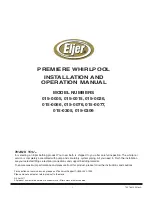
LBL-NVU-PIB r3, Patient Instruction Booklet
Page 4 of 10
Care Professional. It is recommended that you see your Eye Care Professional routinely as
directed.
WARNING:
UV absorbing contact lenses aren’t substitutes for protective UV absorbing eyewear, for
example UV absorbing goggles or sunglasses, because they don’t completely cover the eye
and surrounding area. You should continue to use UV absorbing eyewear as directed.
NOTE:
Long term exposure to UV radiation is a part of the risk factors associated with
cataracts. Exposure is according to a number of factors, for instance environmental conditions
(altitude, geography, cloud cover) and personal factors (extent and nature of outdoor
activities). UV-absorbing contact lenses help provide protection against harmful UV radiation.
However, clinical studies have not been done to demonstrate that wearing UV-absorbing
contact lenses reduces the risk of developing cataracts or other eye disorders. Consult your
Eye Care Professional for more information.
Water Activity
Instruction for Use:
•
Do not expose your contact lenses to water while you are wearing them.
WARNING:
Water can harbor microorganisms that can lead to severe infection, vision loss or
blindness. If your lenses have been submersed in water when swimming in pools, lakes or
oceans, you should discard them and replace them with a new pair. Ask your eyecare
practitioner (professional) for recommendations about wearing your lenses during any
activity involving water.
PRECAUTIONS
Special Precautions for Your Eye Care Professional:
• Due to the small number of patients enrolled in clinical investigation of lenses, all refractive
powers, design configurations, or lens parameters available in the lens material are not
evaluated in significant numbers. Consequently, when selecting an appropriate lens design
and parameters, your Eye Care Professional should consider all characteristics of the lens
that can affect lens performance and ocular health, including oxygen permeability, wettability,
central, and peripheral thickness, and optic zone diameter.
The potential impact of these factors on your ocular health should be carefully weighed
against your need for refractive correction; therefore, the continuing ocular health of you and
lens performance on your eye should be carefully monitored by your Eye Care Professional.
• Before leaving your Eye Care Professional’s office, you should be able to promptly remove
lenses or you should have somebody else available who can remove the lenses for you.
• Your Eye Care Professional should instruct you to remove your lenses immediately if your
eyes become red or irritated.
Your Eye Care Professional should carefully instruct you:
• If the lens sticks (stops moving) on your eye, follow the recommended directions. Your lens
should move freely on your eye for the continued health of your eye. If non-movement of your
lens continues, you should immediately consult your Eye Care Professional.
• Always wash and rinse your hands before handling your lenses. Do not get cosmetics,
lotions, soaps, creams, deodorants, aerosol products or hair sprays in your eyes or on your




























